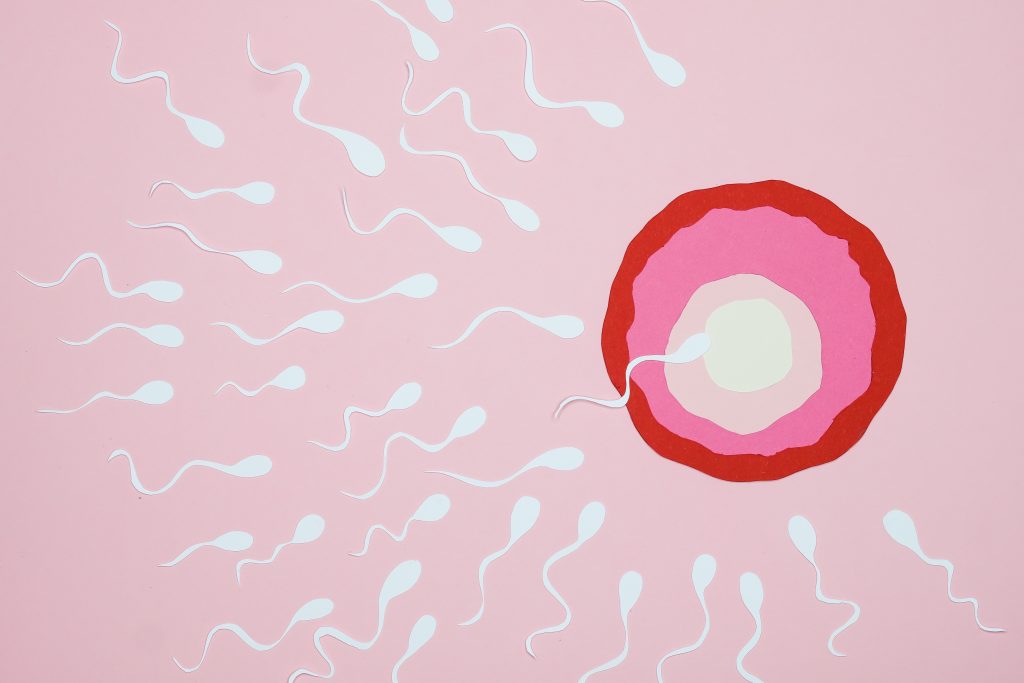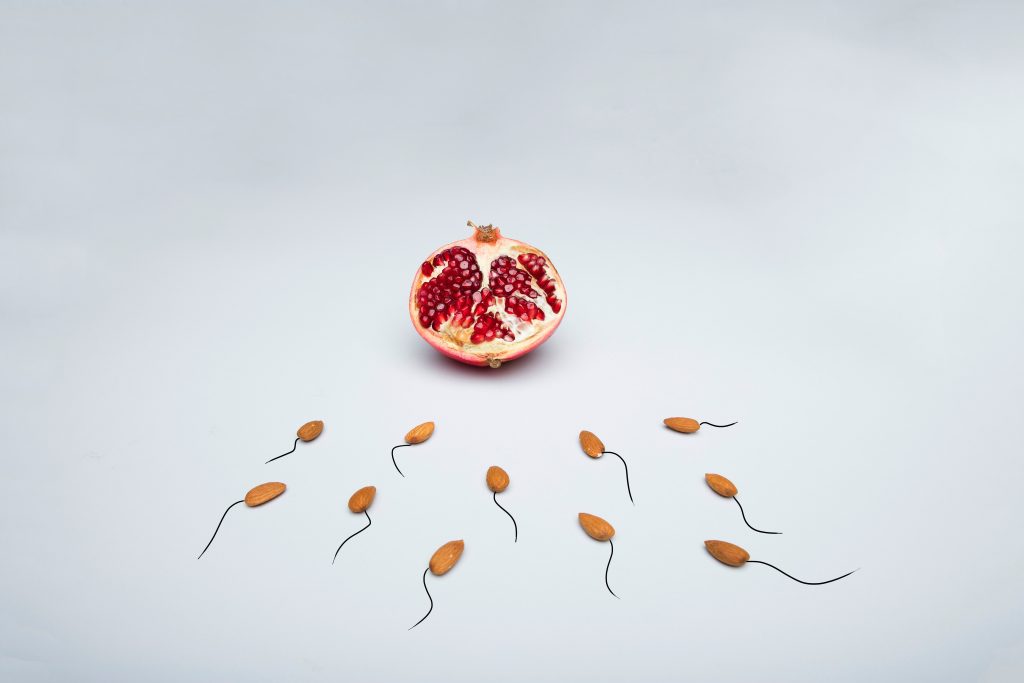
Sperm are the male reproductive cells found in semen. When mature and motile, they are referred to as spermatozoa (singular: spermatozoon). In humans, sperm cells ideally contain 23 chromosomes (half of a human’s genetic material) and may combine with the 23 chromosomes contained in a female’s ovum during fertilization to form a new human being.1
A male’s testes produce sperm in very large numbers through an ongoing process known as spermatogenesis, which starts during puberty and continues until his death.1 When ejaculation occurs during the male orgasm, sperm are expelled from the epididymis through the vas deferens and mixed with seminal fluid in the urethra to make semen, which is expelled through the length of the penis and out the tip. The first fluids emitted during ejaculation contain a higher proportion of sperm.3 In a vasectomy, the vas deferens is surgically obstructed, rendering sperm unable to enter the ejaculate. A single ejaculate may contain up to 500 million individual sperm cells, yet these cells constitute only about 1% of the total ejaculate by volume.2
Table of Contents
Sperm Count
Average ejaculates can contain hundreds of millions of sperm per ejaculate, but the World Health Organization (WHO) considers men with a sperm count lower than 15 million sperm per milliliter to have oligospermia, which means “few sperm.” Men who have no observable amount of sperm in their ejaculate are said to have azoospermia.4 Men with low sperm counts might have difficulty conceiving and may benefit from various forms of assisted reproductive technology. Men with a lower sperm count should still use contraceptives however if they do not wish to conceive.
Sperm Production

Sperm are constantly being produced in the testes through spermatogenesis. During spermatogenesis, sperm stem cells called spermatozoids multiply inside the seminiferous tubules of the testes.1
After undergoing meiosis, which is a special division process for gamete cells (e.g., egg and sperm), the cells are called spermatozoa. Spermatozoa have 23 chromosomes, which is half the amount of chromosomes found in a normal non-reproductive cell. The spermatozoa are then sent to the epididymis where they are stored to mature. It is inside the epididymis that sperm develop the ability to fertilize an ovum.1
During ejaculation, sperm are combined with fluids from the seminal vesicles and the prostate to form the ejaculate. Sperm that never enter this phase continue to mature, die, and are reabsorbed by the body.1 The body is constantly replenishing its supply of sperm, and an average ejaculate contains hundreds of millions of sperm.2
Sperm Anatomy
Sperm are specialized male gamete cells that serve as a carrier for genetic material. They contain special features and organelles that help them fertilize an ovum (egg cell) and induce pregnancy. The following is a list of anatomical structures that comprise each sperm cell:
The Nucleus: Like most cells, the nucleus contains the DNA of sperm. Unlike most cells, however, spermatozoa contain a haploid amount of chromosomes; in humans, this difference means they have 23 chromosomes instead of the regular 46. When a sperm cell fuses with an egg cell in the process called fertilization, the nuclei of both cells also fuse to create a single set of 46 chromosomes. The sperm can be thought of as a transportation device for the male’s genetic material; the sperm cell’s only purpose is to transport genetic material to the egg.1
The Acrosome: This part of the sperm allows it to penetrate the external layers of an ovum since the ovum is surrounded by a protective jelly layer that sperm must pass through. Upon meeting the egg’s protective layer, the sperm releases digestive enzymes from its acrosome in a process known as the acrosome reaction. The sperm’s acrosomal enzymes eat through the protective layer allowing the sperm to reach and fertilize the egg. Only capacitated (further explained below) sperm can produce the acrosomal reaction.1
The Centriole: The centriole is a fibrous structure that is important in the mechanics of flagellar movement, the movement of sperm’s tail structure. Centrioles are composed of fused microtubules, special proteins important in cellular movement and structure. The centrioles extend out into the flagella as the axial filament.1
The Axial Filament: This structure is responsible for the whip-like motion of the sperm’s tail. The centrioles contain a special arrangement of microtubules in the flagella. The fused microtubules slide past each other, making one microtubule longer than the second. This discrepancy in length curves the sperm tail. Rapid alterations in microtubule lengths create the vigorous whipping motion observed in motile sperm.1
The Mitochondrion: Mitochondria are often called the “powerhouse” of the cell. They convert glucose, a simple sugar, into adenosine triphosphate (ATP) which cells use to do work. Sperm use ATP to power the movement of their microtubules and propel themselves forward. When a sperm cell fuses with an egg cell, the sperm cell’s mitochondria is left behind. Because of this separation, all humans inherit their mitochondria from their mother only, and maternal lines may be traced using mitochondrial DNA.1
The Plasma Membrane: Like all cells, sperm have a plasma membrane. The plasma membrane encapsulates the cell and separates it from the external environment. The plasma membrane surrounding the acrosome plays an important role in sperm-egg recognition, sperm capacitation (further explained below), and fertilization.1
Chemical Reactions

A series of chemical reactions take place in the vaginal environment which affect sperm cells. Some of these interactions with the environment of the vagina are required to allow sperm to become capable of fertilizing an egg cell. The second class of chemical reactions make up the process of sperm capacitation, whereby chemical modifications to the plasma membrane of the sperm allow the acrosome reaction and the process of hyperactivation to take place. The acrosome reaction, as described above, allows the sperm cell to fuse with an egg cell, while hyperactivation refers to a process by which a sperm cell becomes increasingly motile as it approaches an egg cell.1
Survivability
Sperm survivability is highly dependent on the environment they are exposed to; temperature, pH, and moisture are key factors in influencing sperm life expectancy.
Semen’s alkalinity, or basic pH, allows it to temporarily neutralize the acidic pH of the vagina to facilitate the passage of sperm. Inside the vagina, sperm typically survive for two days but may also live for up to five. Sperm cannot survive in dry environments; fully dried ejaculate contains no viable sperm. In hot tubs or chlorinated pools, heat and/or chlorine quickly kill sperm. When properly frozen at cryogenic temperatures, as is practiced at sperm banks, sperm may remain viable for years.
References
1. Purves, Sadava, Orians, Heller. Life: the Science of Biology. Courier Companies, Inc., 2003.
2.“Sperm: How Long Sperm Live, Sperm Count, And More”. Web MD. N.p., 2015. Web. 22 May 2017.
3. Hebles M, Dorado M, Gallardo M, González-Martínez M, Sánchez-Martín P. Seminal quality in the first fraction of ejaculate. System Biological Reproductive Medicine, vol. 60, no.1, 2014, pp. 113-116.
4. Cooper, T. G., Noonan, E., von Eckardstein, S., Auger, J., Gordon Baker, H.W., Behre, H. M., Haugen, T. B., Kruger, T., Wang, C., Mbizo, M. T., Vogelsong, K.M. “World Health Organization reference values for human semen characteristics”. Human Reproduction Update, vol. 16, no. 3, 2010, pp. 231–245.
Last Updated: 22 May 2017.
